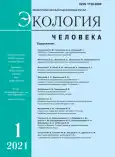EFFECT OF LOW TEMPERATURE ON CARDIOINTERVALS DURING PHYSICAL TRAINING IN MEN
- 作者: Filatova O.E.1, Pyatin V.F.2, Filatov M.A.3, Shakirova L.S.1
-
隶属关系:
- Federal Science Center Scientific-research Institute for System Studies of the Russian Academy of Sciences
- Samara State Medical University
- Surgut State University
- 期: 卷 28, 编号 1 (2021)
- 页面: 17-21
- 栏目: Articles
- URL: https://journals.rcsi.science/1728-0869/article/view/63383
- DOI: https://doi.org/10.33396/1728-0869-2021-1-17-21
- ID: 63383
如何引用文章
全文:
详细
作者简介
O. Filatova
Federal Science Center Scientific-research Institute for System Studies of the Russian Academy of Sciences
V. Pyatin
Samara State Medical University
M. Filatov
Surgut State University
Email: filatovmik@yandex.ru
доктор биологических наук, профессор кафедры экологии и биофизики
L. Shakirova
Federal Science Center Scientific-research Institute for System Studies of the Russian Academy of Sciences
参考
- Bernjak A., Cui J., Iwase S., Mano T., Stefanovska A., Eckberg D. L. Human sympathetic outflows to skin and muscle target organs fluctuate concordantly over a wide range of time-varying frequencies. The Journal of Physiology. 2012, 590 (2), pp. 363-375.
- Brown R., Macefield V. G. Skin sympathetic nerve activity in humans during exposure to emotionally-charged images: sex differences. Frontiers in Physiology. 2014, 5, p. 111.
- Chan N., Choy C. Screening for atrial fibrillation in 13 122 Hong Kong citizens with smartphone electrocardiogram. Heart. 2017, 103, pp. 24-31.
- Dampney R. A. Central neural control of the cardiovascular system: current perspectives. Advances in Physiology Education. 2016, 40 (3), pp. 283-296.
- Eskov V. M. Models of hierarchical respiratory neuron networks. Neurocomputing. 1996, 1 1 (2-4), pp. 203-226.
- Eskov V. M., Filatova O. E. Problem of identity of functional states in neuronal networks. Biophysics. 2003, 48 (3), pp. 497-505.
- Eskov V. M., Gavrilenko T. V., Vokhmina Y. V., Zimin M. I., Filatov M. A. Measurement of chaotic dynamics for two types of tapping as voluntary movements. Measurement techniques. 2014, 57 (6), pp. 720-724.
- Eskov V. M., Eskov V. V, Gavrilenko T. V., Vochmina Y. V. Formalization of the effect of “repetition without repetition” discovered by N. A. Bernshtein. Biophysics. 2017, 62 (1), pp. 143-150.
- Eskov V. V, Gavrilenko T. V, Eskov V. M., Vochmina Yu. V. Static Instability Phenomenon in Type-Three Secretion Systems: Complexity. Technical Physics. 2017, 62 (11), pp. 1611-1616
- Eskov V. M., Filatova O. E., Eskov V. V. and Gavrilenko T. V. The Evolution of the Idea of Homeostasis: Determinism, Stochastics and Chaos-Self-Organization. Biophysics. 2017, 62 (5), pp. 809-820.
- Eskov V. M., Eskov V. V., Vochmina Y. V., Gorbunov D. V., Ilyashenko L. K. Shannon entropy in the research on stationary regimes and the evolution of complexity. Moscow University Physics Bulletin. 2017, 72 (3), pp. 309-317.
- Filatova O. E., Eskov V. V., Filatov M. A., Ilyashenko L. K. Statistical instability phenomenon and evaluation of voluntary and involuntary movements. Russian Journal of Biomechanics. 2017, 21 (3), pp. 224-232.
- Nobrega A., O’Leary D., Silva B. M. et al. Neural regulation of cardiovascular response to exercise: role of central command and peripheral afferents. BioMed. Res. Int. 2014, 2014. Article ID 478965. 20 p.
- Reynard A., Gevirtz R., Berlow R., Brown M., Boutelle K. Heart rate variability as a marker of self-regulation. Applied Psychophysiology and Biofeedback. 2011, 36 (3), pp. 209-215.
- Shaffer F., Ginsberg J. An overview of heart rate variability metrics and norms. Frontiers in public health. 2017, 5, p. 258.
- Spalding T., Jeffers L. Vagal and Cardiac Reactivity to Psychological Stressors in Trained and Untrained Men. Medicine & Science in Sports & Exercise. 2000, 32, pp. 581591. doi: 10.1097/00005768-200003000-00006
- Williamson J. W. Autonomic responses to exercise: where is central command? Autonomic Neuroscience. 2015, 188, pp. 3-4.
- Zilov V. G., Khadartsev A. A., Eskov V. V. and Eskov V. M. Experimental Study of Statistical Stability of Cardiointerval Samples. Bulletin of experimental biology and medicine. 2017, 164 (2), pp. 115-117.
- Zilov V. G., Khadartsev A. A., Eskov V. V., Ilyashenko L. K., Kitanina K. Yu. Examination of statistical instability of electroencephalograms. Bulletin of experimental biology and medicine. 2019, 168 (7), pp. 5-9.
- Zilov V. G., Khadartsev A. A., Eskov V. M., Ilyashenko L. K. New effect in physiology of human nervous muscle system. Bulletin of experimental biology and medicine. 2019, 167 (4), pp. 419-423.
补充文件







